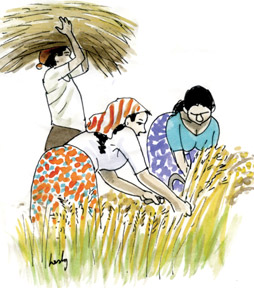Sri Lanka’s galloping economic progress
Dr Mathu H Liyanage
Warring African countries - Ethiopia, Kenya, Somalia and Sudan - are
in the grip of an unprecedented famine caused mainly by tribal warfare,
severe droughts, climate change, rising food prices and diminished
farming investments.
In contrast, Sri Lanka was fortunate in escaping the rigours of the
ruthless 30-year old civil war which not only halted the progress of the
economy but also caused inestimable damage to human resources and the
infrastructure, the peace and tranquillity of the country.
 It was due to the foresight, astuteness and solid determination of
President Mahinda Rajapaksa that it was possible to wipe out terrorism
and implement huge development programmes and agricultural revival
schemes mainly in the North and East that were almost totally destroyed
by the war. The President did not only win the battle of Kilinochchi but
also the Economic War. It was due to the foresight, astuteness and solid determination of
President Mahinda Rajapaksa that it was possible to wipe out terrorism
and implement huge development programmes and agricultural revival
schemes mainly in the North and East that were almost totally destroyed
by the war. The President did not only win the battle of Kilinochchi but
also the Economic War.
According to Bloomberg, an Indian news site, Sri Lanka’s estimated
GDP growth of 8.5 percent is expected to surpass the growth rate of
India’s 8.2 percent during the year. Ironically, the historical and warm
working relationship between the two countries, coming down from times
immemorial, is getting stronger and stronger than even the GDP growth
rate.
Humanitarian crises
The current devastating famines in the African countries ever
recorded in history and the resultant humanitarian crises are, in fact,
reported to be larger in scale than the Japanese tsunami and the Haiti
earthquake. It has caused about 1.5 million people to flee Somalia over
the past several years and the Kenyan refugee camp at Dadaab across
Somalia’s border that was designed for 90,000 people now has 400,000 and
with 10,000 new arrivals per day is overtaking Kisumu as Kenya’s third
largest city, according to Epi Analysis (epidemics, data, and analysis).
US Aid, in its report dated 23/08/2011, says about 3.7 million people
in Somalia, another about 3.7 million people in Kenya, about 4.8 million
in Ethiopia and about 0.16 million in Djibouti are in urgent need of
assistance. It suggests that a multi-sectoral response is critical to
prevent deaths and collapse of livelihood, and social systems across the
region.
Compared with these famine-affected countries, Sri Lanka is now free
from terrorism and is basking in peace and tranquillity.
A lucky country, Sri Lanka is richly rewarded by natural resources
such as an equilateral climate with high average rainfall, fertile land
and land suitable for growing a variety of crops including cash crops,
ample arable land and rivers to generate hydropower.
GDP growth
According to the World Bank’s Global Economic Prospect Report of June
2011, as reported in the Asian Tribune of 07/06/2011, “India and Sri
Lanka will lead the South Asian growth path -reaching 7.9 percent in
2013.” It further says that the “Real Gross Domestic Product (GDP)
growth in Sri Lanka remains buoyant, GDP growth in 2010 (calendar year)
registered 8 percent and has been strongly underpinned by the peace
dividend following the end of the decades-old civil war.”
Sri Lanka’s foreign exchange reserves rose to US $ 7 billion,
skipping over the target, according to a recent announcement made by
Economic Development Minister Basil Rajapaksa.
Remittances from Sri Lankans employed in overseas countries were a
significant contribution to the foreign exchange reserves. According to
the Central Bank, they sent home a record sum of US $ 4.11 billion in
2010 up by nearly 23.6 percent from the previous year. Over 1.5 million
people are employed overseas, especially in the Gulf States, mainly as
unskilled and domestic workers.
Foreign exchange earnings
Foreign exchange earnings from tourism had increased considerably to
US $ 497.4 million in 2010 as compared to US $ 326.3 million in the
previous year, amounting to an increase of 52.4 percent.
Meanwhile, international trade expanded tremendously and the export
earnings during March 2011 surpassed US $ 1 billion and that it grew to
US $ 5,106 million from US $ 3,642 over the corresponding period of
2010, according to the Export Development Board.
There is no doubt that the growth of the economy is shaping extremely
well due to the energetic and sustained efforts of the government, and
the great day to call Sri Lanka the ‘economic hub of Asia’, as envisaged
by President Mahinda Rajapaksa, may not be far away.
|



